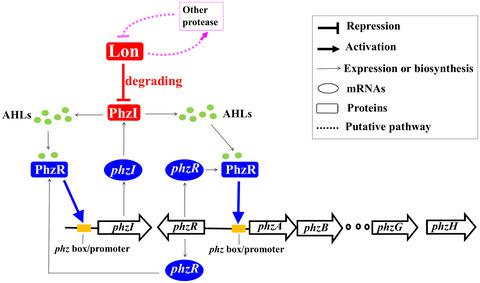当前位置:
X-MOL 学术
›
Mol. Microbiol.
›
论文详情
Our official English website, www.x-mol.net, welcomes your
feedback! (Note: you will need to create a separate account there.)
Lon protease downregulates phenazine-1-carboxamide biosynthesis by degrading the quorum sensing signal synthase PhzI and exhibits negative feedback regulation of Lon itself in Pseudomonas chlororaphis HT66
Molecular Microbiology ( IF 2.6 ) Pub Date : 2021-06-07 , DOI: 10.1111/mmi.14764 Zheng Wang 1 , Xianqing Huang 1 , Malik Jan 1 , Deyu Kong 1 , Wei Wang 1 , Xuehong Zhang 1
Molecular Microbiology ( IF 2.6 ) Pub Date : 2021-06-07 , DOI: 10.1111/mmi.14764 Zheng Wang 1 , Xianqing Huang 1 , Malik Jan 1 , Deyu Kong 1 , Wei Wang 1 , Xuehong Zhang 1
Affiliation

|
Pseudomonas chlororaphis HT66 exhibits strong antagonistic activity against various phytopathogenic fungi due to its main antibiotic phenazine-1-carboxamide (PCN). PCN gene cluster consists of phzABCDEFG, phzH, phzI, and phzR operons. phzABCDEFG transcription is activated by the PhzI/R quorum sensing system. Deletion of the lon gene encoding an ATP-dependent protease resulted in significant enhancement of PCN production in strain HT66. However, the regulatory pathway and mechanism of Lon on PCN biosynthesis remain unknown. Here, lon mutation was shown to significantly improve antimicrobial activity of strain HT66. The N-acyl-homoserine lactone synthase PhzI mediates the negative regulation of PCN biosynthesis and phzABCDEFG transcription by Lon. Western blot showed that PhzI protein abundance and stability were significantly enhanced by lon deletion. The in vitro degradation assay suggested that Lon could directly degrade PhzI protein. However, Lon with an amino acid replacement (S674-A) could not degrade PhzI protein. Lon-recognized region was located within the first 50 amino acids of PhzI. In addition, Lon formed a new autoregulatory feedback circuit to modulate its own degradation by other potential proteases. In summary, we elucidated the Lon-regulated pathway mediated by PhzI during PCN biosynthesis and the molecular mechanism underlying the degradation of PhzI by Lon in P. chlororaphis HT66.
中文翻译:

Lon 蛋白酶通过降解群体感应信号合酶 PhzI 下调吩嗪-1-甲酰胺的生物合成,并在绿假单胞菌 HT66 中表现出 Lon 本身的负反馈调节
Pseudomonas chlororaphis HT66 由于其主要抗生素 phenazine-1-carboxamide (PCN) 而对各种植物病原真菌表现出强烈的拮抗活性。PCN 基因簇由phzABCDEFG、phzH、phzI和phzR操纵子组成。phzABCDEFG转录由 PhzI/R 群体感应系统激活。缺失编码 ATP 依赖性蛋白酶的lon基因导致菌株 HT66 中 PCN 产量的显着增强。然而,Lon 对 PCN 生物合成的调控途径和机制仍然未知。在这里,显示lon突变显着提高了菌株 HT66 的抗菌活性。该ñ-酰基高丝氨酸内酯合酶 PhzI 介导Lon对 PCN 生物合成和phzABCDEFG转录的负调节。Western印迹表明,lon缺失显着增强了PhzI蛋白的丰度和稳定性。体外降解试验表明 Lon 可以直接降解 PhzI 蛋白。然而,Lon 带有氨基酸置换(S 674-A) 不能降解 PhzI 蛋白。Lon 识别区域位于 PhzI 的前 50 个氨基酸内。此外,Lon 形成了一个新的自动调节反馈电路,以通过其他潜在的蛋白酶调节自身的降解。总之,我们阐明了 PCN 生物合成过程中 PhzI 介导的 Lon 调节途径以及P 中Lon 降解 PhzI 的分子机制。 绿藻HT66。
更新日期:2021-06-07
中文翻译:

Lon 蛋白酶通过降解群体感应信号合酶 PhzI 下调吩嗪-1-甲酰胺的生物合成,并在绿假单胞菌 HT66 中表现出 Lon 本身的负反馈调节
Pseudomonas chlororaphis HT66 由于其主要抗生素 phenazine-1-carboxamide (PCN) 而对各种植物病原真菌表现出强烈的拮抗活性。PCN 基因簇由phzABCDEFG、phzH、phzI和phzR操纵子组成。phzABCDEFG转录由 PhzI/R 群体感应系统激活。缺失编码 ATP 依赖性蛋白酶的lon基因导致菌株 HT66 中 PCN 产量的显着增强。然而,Lon 对 PCN 生物合成的调控途径和机制仍然未知。在这里,显示lon突变显着提高了菌株 HT66 的抗菌活性。该ñ-酰基高丝氨酸内酯合酶 PhzI 介导Lon对 PCN 生物合成和phzABCDEFG转录的负调节。Western印迹表明,lon缺失显着增强了PhzI蛋白的丰度和稳定性。体外降解试验表明 Lon 可以直接降解 PhzI 蛋白。然而,Lon 带有氨基酸置换(S 674-A) 不能降解 PhzI 蛋白。Lon 识别区域位于 PhzI 的前 50 个氨基酸内。此外,Lon 形成了一个新的自动调节反馈电路,以通过其他潜在的蛋白酶调节自身的降解。总之,我们阐明了 PCN 生物合成过程中 PhzI 介导的 Lon 调节途径以及P 中Lon 降解 PhzI 的分子机制。 绿藻HT66。











































 京公网安备 11010802027423号
京公网安备 11010802027423号